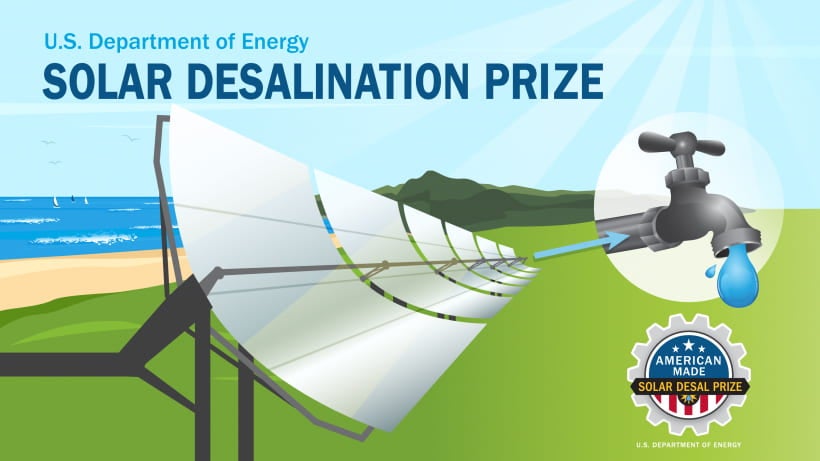A Rice team’s clever design for using the power of the sun to make fresh water from saltwater, even at night, has been chosen as one of eight semifinalists in a Department of Energy (DOE) contest for the $1 million Solar Desalination Prize.
Rice’s “solar thermal resonant energy exchange desalination” system, or STREED, was designed by Rice faculty, staff and alumni, many of whom have worked together on solar desalination for years through Rice’s Nanotechnology Enabled Water Treatment Center (NEWT).
DOE launched the Solar Desalination Prize in April 2020, with a starting field of 162 competitors. Teams receive cash prizes as they advance through the contest’s four stages. The semifinalists named this week by DOE will receive $250,000 in cash and a $100,000 voucher that can be redeemed with qualified partner facilities in the American-Made Network or national laboratories.
Team leader Alessandro Alabastri, an assistant professor of electrical and computer engineering, said he knew it would be difficult to make the cut for the third round of competition. But he had a surefire method of relieving the stress: re-reading his team’s design proposal.
“Every time I was reading the application that we submitted, I liked it,” he said. “I read it again, like one week ago, and actually was like, ‘Yeah. This project is pretty cool.'”
And one of the coolest parts is how STREED holds onto heat. The system uses light-harvesting nanoparticles developed in the lab of Rice’s Naomi Halas to heat salty water or brine and produce steam, which condenses into fresh water. The system is so efficient at harvesting and reusing heat from both the brine and condensate that it is designed to run for hours, producing fresh water long after the sun sets.
“When it condenses, the distilled water is close to the boiling point, but before it gets out of the system it goes back to almost room temperature,” Alabastri said. “And all the heat, that goes back in your system. You recycle the heat as many times as you can, and that makes the process very efficient. We have experimental evidence that we can extend the operation for a few hours after we switch off the light, and we predicted, using models, that you can actually push this production until the next sunrise if the system is well-optimized.”
Other Rice team members are Halas, Peter Nordlander, Pratiksha Dongare ’17, Oara Neumann ’13 and Andrew Treleaven ’13. The team also includes six members from Austin-based company Localized Water Solutions (LWS): Joe Lamy ’98, Tim Dehne ’87, Kyle Wendel, Wayne Wolf, Larry Lien and Patricia Baumhart.
Alabastri, Halas, Nordlander, Dongare and Neumann have worked together for the better part of a decade to advance research in solar desalination, including work funded through NEWT, a national engineering research center at Rice whose industry members include LWS.
For years, the Rice group’s efforts focused on using nanoparticles in conjunction with porous membranes to separate fresh water from brine.
“When we heard about this competition, we wanted to use all that we developed so far, but take it one step further by building on the research we had done in resonant energy exchange and by removing the membranes to really make the system robust,” said Dongare, a postdoctoral research associate in electrical and computer engineering.
Dongare said the team is looking forward to the next phases of the competition, which involve putting ideas into practice and showing they can be scaled up.
“This has just been an idea so far,” she said. “Now we have a diverse team and a plan in place to realize this idea. It’s a modular system. Our next goal is to actually implement it, and combine the modules to such an extent that we can say, ‘Now, using this, we can reach an output of 100 cubic meters per day if we keep going down this path.'”
That’s more than 26,000 gallons of fresh water per day, and to prove it can scale the system to that level, Alabastri and Dongare said the team will need to use all its skills in the lab as well as its industry connections.
“The final goal is the realization of a pilot-scale plant,” Alabastri said. “At Rice, we’re great at research, but when it is time for large-scale production, you cannot do that on campus. That’s where LWS comes in. It’s great to be able to collaborate with companies that do that. They can help us with engineering and eventually also with the marketing and commercialization of the product.”
While completing detailed designs of pilot systems in the third phase, teams must also obtain the permits, approvals and documentation to build them. Teams that advance to the fourth phase will build their systems and must demonstrate operation and meet key performance metrics to win the $1 million prize.
Halas is the Stanley C. Moore Professor of Electrical and Computer Engineering and a professor of chemistry, bioengineering, physics and astronomy, and materials science and nanoengineering. Nordlander is the Wiess Chair and Professor of Physics and Astronomy, and professor of electrical and computer engineering, and materials science and nanoengineering. Neumann is the Carl and Lillian Illig Postdoctoral Research Fellow in Electrical and Computer Engineering. Treleaven, vice president of sales and business development at Axip Energy Services in Houston, worked with Rice’s Office of Technology Transfer to identify commercial potential for Rice nanomaterials during his MBA studies at Rice’s Jesse Jones Graduate School of Business.

